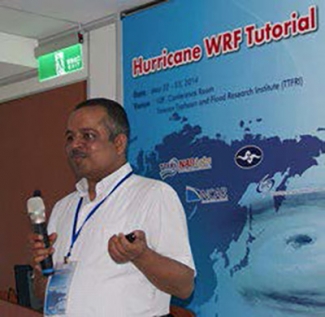The Hurricane Weather Research and Forecasting model (HWRF) is a U.S. operational hurricane prediction model used by the National Hurricane Center for tropical cyclone track and intensity forecasts in its basins of responsibility: North Atlantic and Eastern North Pacific. However, HWRF can be employed in any basin. In 2013 the HWRF real-time runs conducted by the NOAA Environmental Modeling Center (EMC) for the West Pacific basin were found to be very valuable by the Joint Typhoon Warning Center (JTWC). Because of the demonstrated skill of the HWRF model and its advanced capabilities, there has been a strong interest in HWRF from the research community as well as the international weather centers that are responsible for tropical cyclones forecasting. Currently, there are more than 1000 registered users for HWRF. With a goal of encouraging the participation of international research and operational community in the development and applications of HWRF, the NOAA Hurricane Forecast Improvement Project (HFIP) sponsored an HWRF tutorial in Taipei, Taiwan, 22-23 May 2014. The HWRF Tutorial was held immediately following the Workshop on Numerical Prediction of Tropical Cyclones, 20-21 May 2014, which was attended by about 60 scientists from Taiwan, U.S., China, Japan, S. Korea, India, Vietnam, Thailand, the Philippines, and Malaysia. Fred Toepfer, HFIP Program Director, gave a keynote speech at the workshop. The HWRF Tutorial was organized jointly by DTC, EMC, HFIP, Taiwan’s Central Weather Bureau (CWB), and the Taiwan Typhoon Flood Research Inst (TTFRI). Twenty-six students from Malaysia, the UK, Thailand, Vietnam, USA, Singapore, and Taiwan participated. The tutorial instructors included Robert Gall of HFIP, Vijay Tallapragada, Young Kwon, Sam Trahan, Qingfu Liu, and Chanh Kieu of EMC, and Timothy Brown and Ligia Bernardet of DTC. The feedback from the students was overwhelmingly positive, in spite of the torrential rain of 14 inches in 24 hours which fell in Taipei during the event! We anticipate an increased use of HWRF in the West Pacific typhoon community in the years to come, which will lead to valuable collaboration on the continued development on HWRF.
Contributed by Ligia Bernardet, photos by Bill Kuo
Summer 2014
Copyright © 2025. All rights reserved.


